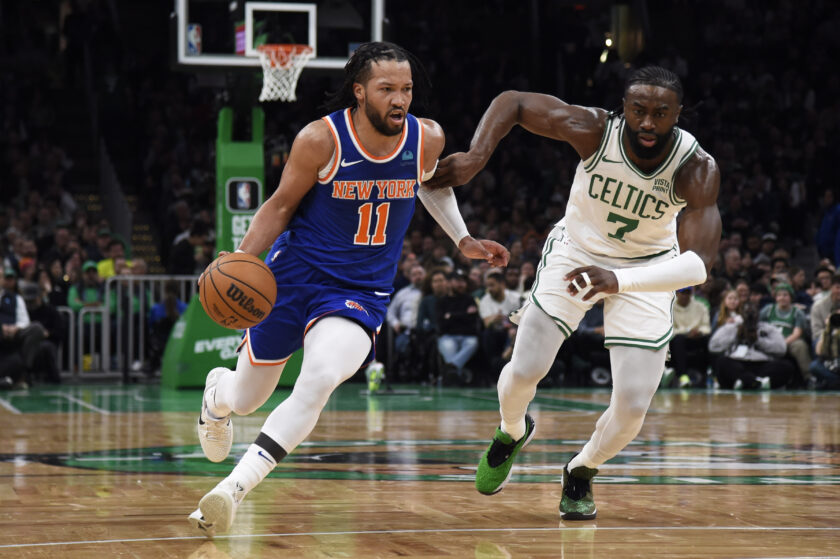New York Knicks: Drafting the all-2000s starting lineup

The 2000s weren’t an easy time to be a New York Knicks fan, but a small handful of players kept New York hoops exciting for everyone.
[sc name=”josh-benjamin-banner” ]Imagine attending an absolutely epic party. The drinks are mixed well, the food is great, and everyone in the room gets along well. Even if they disagree on the stupidest things, they manage to have a great time regardless. As a result, when the party is eventually over, there’s some sadness about it all coming to an end.
Now, take that feeling and multiply it by 10. This is exactly how New York Knicks fans started feeling as the calendar turned to the year 2000. The team went from being a young and exciting squad to a perennial lottery team in an unbelievably quick fashion.
Gone was Patrick Ewing’s dominance and Charlie Ward’s toughness. Larry Johnson’s drive and passion quickly became distant memories. While the 1990s were remembered as the most consistently good era of Knicks basketball in recent history, the 2000s quickly became a three-ring circus under coach and GM Isiah Thomas.
But every cloud has a silver lining and the mediocre New York Knicks teams of the 2000s are no exception. Sure, the team only made the playoffs twice in the whole decade and were eliminated in the first round both times, but the players were still fun.
You know what time it is, folks. Dig out your old iPod Nano and start blasting the soundtrack from The OC. It’s time to draft the Knicks’ All-2000s team.
Honorable Mention: Jamal Crawford (Knicks tenure: 2004-2008)
https://www.youtube.com/watch?v=vuwdQK5BwHI
When all is said and done, Jamal Crawford will be remembered as a player who just played at a high level no matter what jersey he wore. The New York Knicks are one of eight teams with whom the former Michigan Wolverine spent his career. Even in his final season, at age 38 with the Phoenix Suns, he was posting 15.1 points per 36 minutes.
And when the Knicks acquired Crawford from the Chicago Bulls in 2004, he immediately proved to be a good fit amongst the brewing chaos. He immediately posted a then-career-high 17.7 points per game. Three years later, he averaged over 20 points per contest for the only time in his career.
On the whole, Crawford averaged 17.6 points per game as a Knick despite shooting a meager 40.7% from the field. Early in the 2008 season, he was dealt to the Golden State Warriors for Al Harrington in a cost-cutting measure.
So why is Crawford only an honorable mention? Well, solid scoring aside, he really isn’t best known for his years with the Knicks. He never once posted win shares per 48 minutes (WS/48) above .100 and was mostly a better player on an overall bad team.
He was fun to watch as a Knick, but not an all-time New York great.
PG: Stephon Marbury (Knicks tenure: 2004-2009)

Every New York Knicks fan had reason to be excited for Stephon Marbury. He was a strong and athletic scoring point guard who could also distribute the ball with ease. More importantly, he grew up in Brooklyn and was now coming home to play for the Knicks. Throw in that new team president and GM Isiah Thomas landed Marbury from the Phoenix Suns for practically nothing, and this move was absolutely lauded.
Sure enough, Marbury averaged 19.8 points and 9.3 assists in his first season as a Knick. New York made the playoffs as the No. 6 seed in 2004 and even with a first-round exit, Marbury gave fans hope.
The hope was short-lived. Marbury’s tenure was marked by constant clashes with coaches, namely Hall of Famer Larry Brown. Thomas took over as coach after Brown’s lone season in 2005-06, and Marbury’s decline began. He was eventually bought out of his contract in 2009 and further made a name for himself playing in China.
Still, the man was called “Starbury” for a reason. He averaged 18.2 points and seven assists for the Knicks and posted a true shooting percentage (TS%) of 54.6%. His turning New York basketball into a soap opera aside, Marbury is hands-down the Knicks’ best point guard of the 2000s.
SG: Allan Houston (Knicks tenure: 1996-2005)

New York Knicks fans have a love-hate relationship with Allan Houston. On one hand, he averaged 18.5 points per game as a Knick and his scoring prowess was a big help as Ewing declined. On the other hand, the $100.4 million contract he signed with New York in 2001 gave birth to what was then called the “Allan Houston Rule.”
And even though Houston’s sudden slew of knee injuries forced his early retirement in 2005, he’s easily the team’s best two-guard of the 2000s. He shot nearly 40% from three-point range as a Knick. In 2002-03, he posted a career-best 22.5 points per game despite the Knicks struggling as a whole. He managed to be an effective three-point shooter and scorer without depending on his long-range shot.
It doesn’t matter that Houston’s contract proved to be an albatross. When he was healthy, his knack for scoring in bunches gave Knicks fans hope for a brighter future.
SF: Latrell Sprewell (Knicks tenure: 1999-2003)

I was barely a teenager when the New York Knicks traded for Latrell Sprewell, but I still remember how polarizing a deal it was. On one hand, Sprewell was an athletic and fiery wing who averaged 20.1 points per game in six years with the Golden State Warriors.
However, he was also suspended for all but 14 games of the previous season after choking Warriors coach P.J. Carlesimo at practice. On top of that, the Knicks gave up the universally beloved John Starks in the trade and Larry Johnson was penciled in at small forward. Why was yet another athletic forward being acquired?
One word, Knicks fans: energy. Sprewell was the Knicks’ sixth man in his first New York season and the burst he provided off the bench was instrumental in the team’s run to the 1999 NBA Finals. He spent the next four years as a starter and averaged 17.9 points per game in five years with the Knicks.
And though Sprewell only shot a modest 41.8% from the field as a Knick, he was still effective with his shot selection. His TS% was a respectable 50.3 in New York and Sprewell also proved capable on defense, though not at all elite.
The former Alabama standout was later sent to the Minnesota Timberwolves in a cost-cutting move in 2003. Though necessary for money reasons, the Knicks losing Sprewell also meant the team lost some of its edge.
PF: David Lee (Knicks tenure: 2005-2010)
https://www.youtube.com/watch?v=MqaqqSC_9Go
Initially, New York Knicks fans viewed David Lee as a bonus in the 2005 NBA Draft. The team had seemingly drafted Patrick Ewing’s heir in Channing Frye at No. 8. Fiery and athletic point man Nate Robinson was picked at No. 21 after a trade with the Suns. What could Isiah possibly do with the No. 30 pick, the last in the first round?
Enter Lee, who exceeded all expectations after posting a modest 11.3 points and six boards per game in four years at Florida. He only averaged 5.1 points and 4.5 rebounds as a rookie, but became a double-double machine over the next four years.
All in all, Lee averaged 13 points and 9.6 rebounds as a Knick and also shot a respectable 55.7% from the field. The deeper numbers make him look even better. His TS% was 60, his WS/48 an above-average .150, and he even posted a VORP of 9.0 in five years.
Bad timing ultimately forced the Knicks to move on from Lee. He hit free agency the same summer a slew of elite talent did, namely LeBron James. Given how the Knicks spent the preceding years clearing enough cap space to pursue these talents, Lee went to the Warriors in a sign-and-trade.
His New York tenure was short, but Lee was yet another player this decade whose hard work gave Knicks fans hope for the future.
C: Eddy Curry (Knicks tenure: 2005-2011)

The story of Eddy Curry’s basketball career is Allan Houston Rule. The Chicago Bulls drafted the 7-footer out of high school with the No. 4 pick in 2001 and while he led the league in field goal percentage his second year, he wasn’t as dominant as advertised. In 2005, the youngster once dubbed “Baby Shaq” was traded to the New York Knicks for Tim Thomas and draft picks.
In a nutshell, Curry’s Knicks tenure wasn’t good. He averaged 15.2 points and 5.8 rebounds in five years, but only played in 222 total games. Despite his size, he was slow on his feet and not a strong defender.
But for one glorious 2006-07 season, even as the Knicks stumbled to 33 wins, Curry managed a career season. His 19.5 points per game led the Knicks and his seven rebounds per contest wound up being his career-high. Curry also played in 81 games, the fourth and final time he ever appeared in over 70 games in a season.
The point is this era of Knicks basketball was largely defined by New York regularly shaking up its roster. Turnover was rampant and, on the whole, Curry is here because he’s the best center amongst the mediocre. I’ll give the Jerome James defenders two minutes for rebuttal now.
Curry was eventually moved via the Carmelo Anthony trade in 2011 and he is often considered one of the front office’s worst acquisitions. Still, for that one season, there was hope that maybe he could dominate the paint in the long term.
Josh Benjamin has been a staff writer at ESNY since 2018. He has had opinions about everything, especially the Yankees and Knicks. He co-hosts the “Bleacher Creatures” podcast and is always looking for new pieces of sports history to uncover, usually with a Yankee Tavern chicken parm sub in hand.





